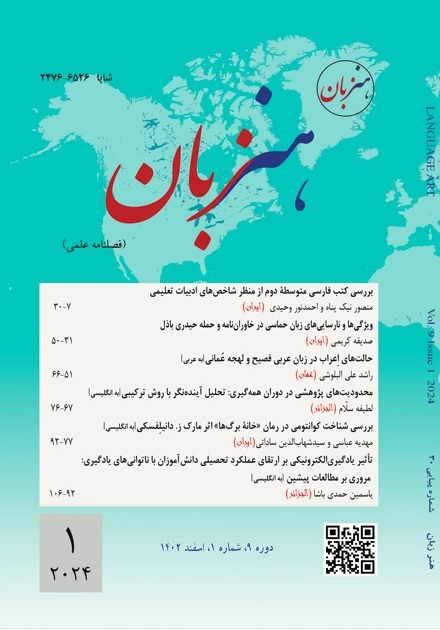حالتهای اِعراب در زبان عربی فصیح و لهجه عُمانی
DOI::
https://doi.org/10.22046/LA.2024.03کلمات کلیدی:
اعراب ساختاری, اعراب فعلی, اعراب صرفی, توافق, نیابتچکیده
این مقاله به بررسی مفهوم «اعراب ساختاری» و نقش نحوی آن میپردازد و همچنین ویژگیهای فعلی را تحلیل میکند که بر اساس آنها، حالت فاعلیِ ساختاری به نهاد و حالت مفعولیِ ساختاری به مفعول در زبان عربی فصیح تخصیص مییابد. مقاله دربردارندۀ نقدی بر برخی رویکردهای رایج (مطرحشده در چارچوب زبانشناسی زایشی) درباره ماهیت این ویژگیهاست. سپس رویکردی نوین برای تبیین دادههای مربوط به اعراب ساختاری در زبان عربی فصیح ارائه میشود. همچنین مقاله به بررسی سازوکاری میپردازد که لهجه عُمانی ــ گونهای از عربی که اسمها در آن اعراب صرفی ندارند ــ برای تحقق نقش نحویِ اعراب ساختاری بهکار میگیرد. در پایان، پرسشی در ارتباط با این سازوکار در مقایسه با زبان عربی فصیح طرح میشود و پاسخی مستدل به آن ارائه میگردد.
مراجع
القرآن الكريم
البلوشي، راشد (2020). مراجعاتٌ في نحو اللغة العربية. المجلة الدولية للسانيات العربية، 6(1–2)، 45–67.
حسن، عباس (1974). النحو الوافي: مع ربطه بالأساليب الرفيعة والحياة اللغوية المتجددة (الطبعة الثالثة). القاهرة: مطبعة دار المعارف.
النادري، محمد أسعد (1997). نحو اللغة العربية: كتابٌ في قواعد النحو والصرف (الطبعة الثانية). بيروت: المكتبة العصرية.
The Noble Quran.
Al-Balushi, R. (2011). Case in Standard Arabic: The untraveled paths [Unpublished doctoral dissertation]. University of Toronto, Toronto, Canada.
Al-Balushi, R. (2013). Verbal and nominal case suffixes in Standard Arabic: A unified account. Brill’s Annual of Afroasiatic Languages and Linguistics, 5(1), 35–82.
Al-Balushi, R. (2016). The believe-construction in Standard Arabic. Journal of Linguistics, 52(1), 1–36.
Al-Balushi, R. (2018). The relationship between agreement and morphological case: Evidence from Arabic. Concentric: Studies in Linguistics, 44(2), 69–109.
Al-Balushi, R. (2019). Subject licensing in non-verbal clauses in Arabic. Brill’s Journal of Afroasiatic Languages and Linguistics, 11(2), 249–282.
Al-Balushi, R. (2020). Murājaʿātun fī naḥwi al-lughati al-ʿarabiyya. al-Majalla al-dawliyya li-lisāniyyāt al-ʿarabiyya, 6(1–2), 45–67.
al-Nādiri, M. A. (1997). Naḥwu al-lughati al-ʿarabiyya: Kitābun fī qawāʿidi al-naḥwi wa-l-ṣarf (al-ṭabʿa al-thāniya). al-Maktaba al-ʿAṣriyya.
Aoun, J. (1979). On government, case-marking and clitic placement [Unpublished manuscript]. MIT.
Bennis, H. (2007). Featuring the subject in Dutch imperatives. In W. van der Wurff (Ed.), Imperative clauses in generative grammar (pp. 113–134). John Benjamins.
Burzio, L. (1986). Italian syntax: A government-binding approach. Reidel.
Chomsky, N. (1980). On binding. Linguistic Inquiry, 11(1), 1–46.
Chomsky, N. (1981). Lectures on government and binding. Foris.
Chomsky, N. (2001). Derivation by phase. In M. Kenstowicz (Ed.), Ken Hale: A life in language (pp. 1–52). MIT Press.
Cowper, E. (2005). The geometry of interpretable features: Infl in English and Spanish. Language, 81(1), 10–46.
Fabb, N. A. J. (1984). Syntactic affixation [Unpublished doctoral dissertation]. MIT.
Fassi Fehri, A. (1993). Issues in the structure of Arabic clauses and words. Kluwer.
Fassi Fehri, A. (2009). A lexicon of linguistic terms. Dar al-Kitab al-Jadid.
George, L., & Kornfilt, J. (1981). Finiteness and boundedness in Turkish. In F. Heny (Ed.), Binding and filtering (pp. 105–127). MIT Press.
Han, C. (1998). The structure and interpretation of imperatives: Mood and force in universal grammar [Unpublished doctoral dissertation]. University of Pennsylvania.
Ḥasan, ʿA. (1974). al-Naḥw al-wāfī: Maʿa rabṭihi bi-l-asālīb al-rafīʿa wa-l-ḥayāt al-lughawiyya al-mutadjaddida (al-ṭabʿa al-thālitha). Maṭbaʿat Dār al-Maʿārif.
Henry, A. (1995). Belfast English and Standard English: Dialect variation and parameter setting. Oxford University Press.
Legate, J. A. (2008). Morphological and abstract case. Linguistic Inquiry, 39(1), 55–101.
Mohammad, M. A. (1990). The problem of subject-verb agreement in Arabic: Towards a solution. In M. Eid (Ed.), Perspectives on Arabic linguistics (pp. 95–125). John Benjamins.
Mohammad, M. A. (2000). Word order, agreement and pronominalization in Standard and Palestinian Arabic. John Benjamins.
Ouhalla, J. (1994). Verb movement and word order in Arabic. In D. Lightfoot & N. Hornstein (Eds.), Verb movement (pp. 41–72). Cambridge University Press.
Pesetsky, D., & Torrego, E. (2001). T-to-C movement: Causes and consequences. In M. Kenstowicz (Ed.), Ken Hale: A life in language (pp. 355–426). MIT Press.
Pesetsky, D., & Torrego, E. (2004). Tense, case, and the nature of syntactic categories. In J. Guéron & J. Lecarme (Eds.), The syntax of time (pp. 495–538). MIT Press.
Roberts, I. G. (1985a). The representation of implicit and dethematized subjects [Unpublished doctoral dissertation]. University of Southern California.
Roberts, I. G. (1985b). Agreement parameters and the development of English modal auxiliaries. Natural Language and Linguistic Theory, 3(1), 21–58.
Roeper, T., & Vergnaud, J.-R. (1980). The government of infinitives [Unpublished manuscript]. University of Massachusetts, Amherst.
Rupp, L. M. (1999). Aspects of the syntax of English imperatives [Unpublished doctoral dissertation]. University of Essex.
Ryding, K. (2005). A reference grammar of Modern Standard Arabic. Cambridge University Press.
Schütze, C. (1997). INFL in child and adult language: Agreement, case, and licensing [Unpublished doctoral dissertation]. MIT.
Schütze, C. (2001). On the nature of default case. Syntax, 4(3), 205–238.
Soltan, U. (2007). On formal feature licensing in minimalism: Aspects of Standard Arabic morphosyntax [Unpublished doctoral dissertation]. University of Maryland.
Wright, W. (1896). A grammar of the Arabic language (Vol. 1). Cambridge University Press. (Original work published 1859)
Zagona, K. (1982). Government and proper government of verbal projections [Unpublished doctoral dissertation]. University of Washington.
Zanuttini, R. (1991). Syntactic properties of sentential negation: A comparative study of Romance languages [Unpublished doctoral dissertation]. University of Pennsylvania.
##submission.downloads##
چاپ شده
ارجاع به مقاله
شماره
نوع مقاله
مجوز
حق نشر 2024 Rashid Al-Balushi

این پروژه تحت مجوز بین المللی Creative Commons Attribution 4.0 می باشد.
فصلنامه هنر زبان یک مجله دسترسی آزاد است و مقالات پس از پذیرش در دسترس عموم قرار می گیرند و استفاده از آن با ذکر منبع آزاد است
